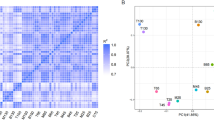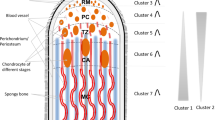Abstract
Deer antlers are well known for their regeneration and rapid growth. However, little is known about the genes that are involved in their development, especially the molecular mechanisms responsible for rapid growth. In the present study, we produced more than 41 million sequencing reads using the Illumina sequencing platform. These reads were assembled into 89,001 unique sequences (mean size: 450 bp), representing more than 58 times as many Sika deer sequences previously available in the NCBI database (as of Sep 15, 2011). Based on a similarity search with known proteins, we identified 40,088 sequences with a cut-off E value of 10−5. Assembled sequences were then annotated using Gene ontology terms, Clusters of Orthologous Groups classifications, and Kyoto Encyclopedia of Genes and Genomes pathways. In addition, we found a number of highly expressed genes involved in the regulation of Sika deer antler rapid growth, including transcription factors, signaling molecules, and extracellular matrix proteins. Our data represent the most comprehensive sequence resource available for the deer antler and provide a basis for new research on deer antler molecular genetics and functional genomics.


Similar content being viewed by others
Abbreviations
- GO:
-
Gene ontology
- COGs:
-
Clusters of Orthologous Groups of proteins
- KEGG:
-
Kyoto Encyclopedia of Genes and Genomes
References
Pita-Thomas W, Fernández-Martos C, Yunta M et al (2010) Gene expression of axon growth promoting factors in the deer antler. PLoS ONE 5:e15706. doi:10.1371/journal.pone.0015706
Li C, Yang F, Sheppard A (2009) Adult stem cells and mammalian epimorphic regeneration-insights from studying annual renewal of deer antlers. Curr Stem Cell Res T 4:237–251
Price J, Allen S (2004) Exploring the mechanisms regulating regeneration of deer antlers. Philos Trans R Soc Lond B Biol Sci 359:809–822
Metzker ML (2009) Sequencing technologies—the next generation. Nat Rev Genet 11:31–46
Wang Z, Gerstein M, Snyder M (2009) RNA-Seq: a revolutionary tool for transcriptomics. Nat Rev Genet 10:57–63
Schroeder A, Mueller O, Stocker S et al (2006) The RIN: an RNA integrity number for assigning integrity values to RNA measurements. BMC Mol Biol 7:3
Li R, Zhu H, Ruan J et al (2010) De novo assembly of human genomes with massively parallel short read sequencing. Genome Res 20:265–272
Lee Y, Tsai J, Sunkara S et al (2005) The TIGR Gene Indices: clustering and assembling EST and known genes and integration with eukaryotic genomes. Nucleic Acids Res 33:D71–D74
Mortazavi A, Williams BA, Mccue K, Schaeffer L, Wold B (2008) Mapping and quantifying mammalian transcriptomes by RNA-Seq. Nat Methods 5:1–8
Camacho C, Coulouris G, Avagyan V et al (2009) BLAST+: architecture and applications. BMC Bioinformatics 10:421
Conesa A, Götz S, García-Gómez JM et al (2005) Blast2GO: a universal tool for annotation, visualization and analysis in functional genomics research. Bioinformatics 21:3674–3676
Harris MA, Clark J, Ireland A et al (2004) The gene ontology (GO) database and informatics resource. Nucleic Acids Res 32:D258–D261
Tatusov RL, Natale DA, Garkavtsev IV et al (2001) The COG database: new developments in phylogenetic classification of proteins from complete genomes. Nucleic Acids Res 29:22–28
Kanehisa M, Goto S, Kawashima S, Okuno Y, Hattori M (2004) The KEGG resource for deciphering the genome. Nucleic Acids Res 32:D277–D280
Gao Z, Li C (1988) The study on the relationship between antler’s growth rate, relative bone mass and circulation testosterone, estradiol, AKP in sika deer. Acta Vet Zootech Sin 19:224–231
Banks WJ, Newbrey JW (1982) Light microscopic studies of the ossification process in developing antlers. In: Brown RD (ed) Antler development in Cervidae. Caesar Kleberg Wildl Res Inst, Kingsville, pp 231–260
Colitti M, Allen SP, Price JS (2005) Programmed cell death in the regenerating deer antler. J Anat 207:339–351
Hudson ME (2008) Sequencing breakthroughs for genomic ecology, and evolutionary biology. Mol Ecol Resour 8:3–17
Li C, Suttie JM (1994) Light microscopic studies of pedicle and early first antler development in red deer (Cervus elaphus). Anat Rec 239:198–215
Hartmann C (2009) Transcriptional networks controlling skeletal development. Curr Opin Genet Dev 19:437–443
Wang W, Lian N, Li L et al (2009) Atf4 regulates chondrocyte proliferation and differentiation during endochondral ossification by activating Ihh transcription. Development 136:4143–4153
Arnold Ma, Kim Y, Czubryt MP et al (2007) MEF2C transcription factor controls chondrocyte hypertrophy and bone development. Dev Cell 12:377–389
Bendall AJ, Hu G, Levi G, Abate-Shen C (2003) Dlx5 regulates chondrocyte differentiation at multiple stages. Int J Dev Biol 47:335–344
Kameda T, Watanabe H, Iba H (1997) C-Jun and JunD suppress maturation of chondrocytes. Cell Growth Differ 8:495–503
Hess J, Hartenstein B, Teurich S et al (2003) Defective endochondral ossification in mice with strongly compromised expression of JunB. J Cell Sci 116:4587–4596
Hattori T, Müller C, Gebhard S et al (2010) SOX9 is a major negative regulator of cartilage vascularization, bone marrow formation and endochondral ossification. Development 137:901–911
Hinoi E, Bialek P, Chen YT et al (2010) Runx2 inhibits chondrocyte proliferation and hypertrophy through its expression in the perichondrium. Gene Dev 20:2937–2942
Trackman PC (2005) Diverse biological functions of extracellular collagen processing enzymes. J Cell Biochem 96:927–937
Ivkovic S (2003) Connective tissue growth factor coordinates chondrogenesis and angiogenesis during skeletal development. Development 130:2779–2791
Li TF, O’Keefe RJ, Chen D (2005) TGF-β signaling in chondrocytes. Front Biosci 10:681–688
French DM, Kaul RJ, D’Souza AL et al (2004) WISP-1 is an osteoblastic regulator expressed during skeletal development and fracture repair. Am J Pathol 165:855–867
Fisher MC, Meyer C, Garber G, Dealy CN (2005) Role of IGFBP2, IGF-I and IGF-II in regulating long bone growth. Bone 37:741–750
Mak KK, Kronenberg HM, Chuang PT, Mackem S, Yang Y (2008) Indian hedgehog signals independently of PTHrP to promote chondrocyte hypertrophy. Development 135:1947–1956
Grimsrud CD, Romano PR, D’Souza M et al (1999) BMP-6 is an autocrine stimulator of chondrocyte differentiation. J Bone Miner Res 14:475–482
Carlevaro MF, Cermelli S, Cancedda R, Descalzi Cancedda F (2000) Vascular endothelial growth factor (VEGF) in cartilage neovascularization and chondrocyte differentiation: auto-paracrine role during endochondral bone formation. J Cell Sci 113:59–69
Price JS, Oyajobi BO, Nalin AM et al (1996) Chondrogenesis in the regenerating antler tip in red deer: expression of collagen types I, IIA, IIB, and X demonstrated by in situ nucleic acid hybridization and immunocytochemistry. Dev Dynam 205:332–347
Rucklidge GJ, Milne G, Bos KJ, Farquharson C, Robins SP (1997) Deer antler does not represent a typical endochondral growth system: immunoidentification of collagen type X but little collagen type II in growing antler tissue. Comp Biochem Phys B 118:303–308
Wilsman NJ, Farnum CE, Leiferman EM, Fry M, Barreto C (1996) Differential growth by growth plates as a function of multiple parameters of chondrocytic kinetics. J Orthop Res 14:927–936
Provot S, Schipani E (2005) Molecular mechanisms of endochondral bone development. Biochem Bioph Res Co 328:658–665
Kobayashi T, Kronenberg H (2005) Minireview: transcriptional regulation in development of bone. Endocrinology 146:1012–1017
Lu Valle P, Iwamoto M, Fanning P, Pacifici M, Olsen BR (1993) Multiple negative elements in a gene that codes for an extracellular matrix protein, collagen X, restrict expression to hypertrophic chondrocytes. J Cell Biol 121:1173–1179
Acknowledgments
This study was supported by the National Key Technology Research and Development Program of the Ministry of Science and Technology of China (Grant No. 2011BAI03B00), and the National Science and Technology Major Project of the Ministry of Science and Technology of China (Grant No. 2011ZX09401-305-09).
Author information
Authors and Affiliations
Corresponding authors
Electronic supplementary material
Below is the link to the electronic supplementary material.
Rights and permissions
About this article
Cite this article
Yao, B., Zhao, Y., Wang, Q. et al. De novo characterization of the antler tip of Chinese Sika deer transcriptome and analysis of gene expression related to rapid growth. Mol Cell Biochem 364, 93–100 (2012). https://doi.org/10.1007/s11010-011-1209-3
Received:
Accepted:
Published:
Issue Date:
DOI: https://doi.org/10.1007/s11010-011-1209-3




